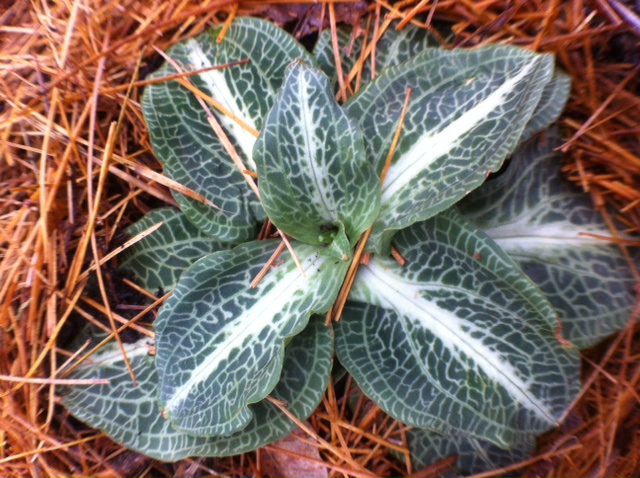Our living collection at Crystal Bridges is a diverse one. It includes 91 species and cultivars of native trees, 54 species and cultivars of native shrubs, and 187 species and cultivars of native perennials. Perhaps our most interesting family of plants are those in the Orchidaceae family, or the orchids. Currently we have six plants that represent this family: Spring Coral Root, Ladies Tresses, Philipp Lady’s-slipper, Rattlesnake Plantain, Crane-fly Orchid, and Putty Root. The latter three will be my focus here, as they have interesting foliage through the fall, winter, and spring months.
Rattlesnake Plantain (Goodyera pubescens) is truly a four-season perennial. It has bluish-green foliage with white venations that resemble a rattlesnake pattern, hence the common name “Rattlesnake” Plantain. The evergreen leaves grow close to the ground and can be used as a native groundcover. The foliage is complimented nicely in late-summer (August-September) with a 6-18”-tall spike with tightly packed white blooms. Plant this in well-drained woodland conditions with a layer of compost for best results. A top-dressing of pine needles not only contrasts nicely with the foliage, but helps with this acid-loving terrestrial orchid. You can find this gem along the south end of the Tulip Tree Trail near Crystal Pond as well around the Tulip Tree Shelter. (Click here to read about the planting of these native orchids in garden beds once maintained by Dr. Neil Compton.)
The fun begins with name of the next orchid, the “Putty Root” (Aplectrum hyemale). The name was chosen for the mucus-like substance that has been historically used to mend broken pottery. The fun continues in the fall when a 5-7” pleated green leaf emerges. Silver stripes break up the monotony of the green on the leaf to add contrast to the autumn shades of the fallen leaves. This color persists through winter. In the spring, it dies down to the ground; however, right before it withers away for the season, a flower stalk appears with yellow and purple blooms (May-June). These blooms give way to attractive pendulous seed pods. After the seeds disperse and the stalk withers, the process starts over with the emergence of the single leaf. Woodland environments with moist conditions (not soggy, though) and a layer of compost will help this plant be a star in your garden. You can see this now near the Rattlesnake Plantains on the Tulip Tree Trail.
Crane-fly Orchid (Tipularia discolor) is a wonderful woodland orchid that is often overlooked. Its 2-3” glossy green leaf emerges in the fall among the masses of fallen leaves. Not too spectacular until you tilt the leaf over to reveal its purple underside. This color will persist through the winter and spring, then it vanishes right before its main attraction: the 1.5 to 2’-tall spike that houses the green and purple blooms (July-September).
The half-inch blooms resemble its namesake, the crane fly. The structure of the blooms are well evolved, as they have a long spur that forces its only pollinator, the noctuid moth, to reach deep into the flower for the nectar. This allows the pollen to attach to the moth’s compound eyes and pollination occurs. The flowers fade in the fall to give way to the single leaf. Plant this in woodland conditions with a layer of compost and keep moist, but not wet. If you find the other orchids that are listed on Crystal Bridges’ grounds, you’ll find this one right with them.








